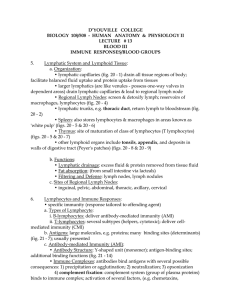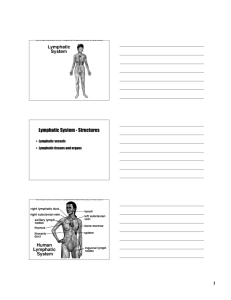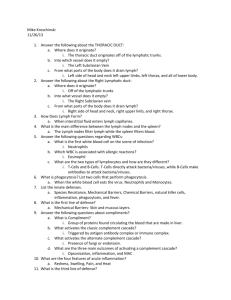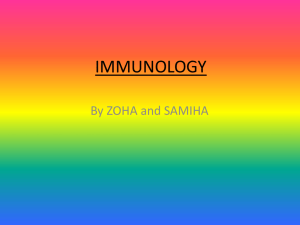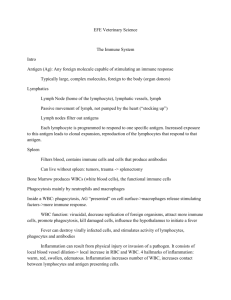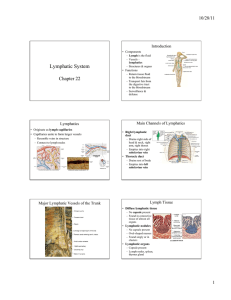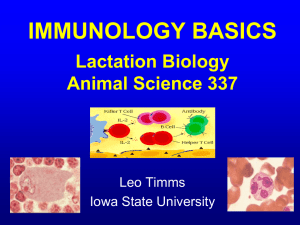Lymphatic and Immune System
advertisement
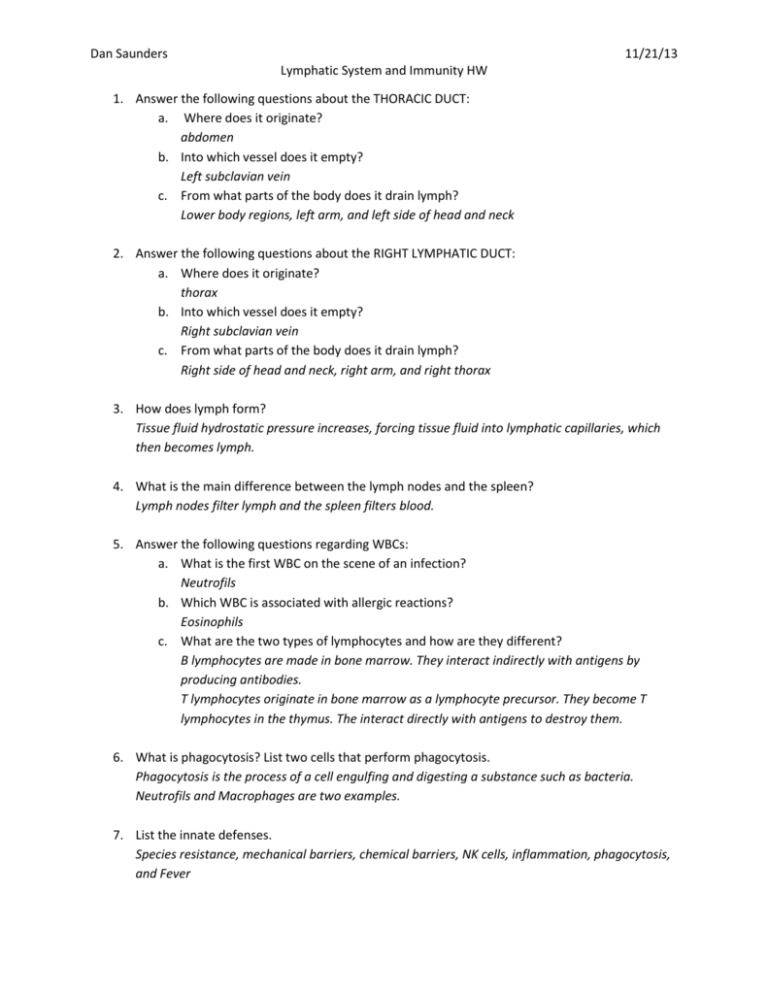
Dan Saunders 11/21/13 Lymphatic System and Immunity HW 1. Answer the following questions about the THORACIC DUCT: a. Where does it originate? abdomen b. Into which vessel does it empty? Left subclavian vein c. From what parts of the body does it drain lymph? Lower body regions, left arm, and left side of head and neck 2. Answer the following questions about the RIGHT LYMPHATIC DUCT: a. Where does it originate? thorax b. Into which vessel does it empty? Right subclavian vein c. From what parts of the body does it drain lymph? Right side of head and neck, right arm, and right thorax 3. How does lymph form? Tissue fluid hydrostatic pressure increases, forcing tissue fluid into lymphatic capillaries, which then becomes lymph. 4. What is the main difference between the lymph nodes and the spleen? Lymph nodes filter lymph and the spleen filters blood. 5. Answer the following questions regarding WBCs: a. What is the first WBC on the scene of an infection? Neutrofils b. Which WBC is associated with allergic reactions? Eosinophils c. What are the two types of lymphocytes and how are they different? B lymphocytes are made in bone marrow. They interact indirectly with antigens by producing antibodies. T lymphocytes originate in bone marrow as a lymphocyte precursor. They become T lymphocytes in the thymus. The interact directly with antigens to destroy them. 6. What is phagocytosis? List two cells that perform phagocytosis. Phagocytosis is the process of a cell engulfing and digesting a substance such as bacteria. Neutrofils and Macrophages are two examples. 7. List the innate defenses. Species resistance, mechanical barriers, chemical barriers, NK cells, inflammation, phagocytosis, and Fever 8. What is the “first line of defense?” Be specific. Mechanical barriers such as skin and mucous membranes 9. Answer the following questions about complement: a. What is complement? Compliment is a group of proteins found circulating in the blood b. What activates the classic complement cascade? When complement protein binds to an antibody attached to its antigen c. What activates the alternate complement cascade? Exposure to foreign antigens d. What are the three main outcomes of activating a complement cascade? Opsonization, inflammation, and Membrane Attack Complex 10. What are the four features of acute inflammation? Rubor, Dolor, Calor, Tumor (Redness, pain, heat, swelling) 11. What is the “third line of defense?” Adaptive Defenses (immunity) 12. What is an antigen? A molecule that can elicit an immune response 13. Where do T cells mature? Where do B cell mature? T cells mature in the Thymus. B cells mature in bone marrow. 14. What is an Antigen Presenting Cell? An APC is a cell that displays and antigen so that immune cells can defend against the antigen. a. List the two main APCs. Macrophages and B cells b. How do APCs work? The APC phagocytoses an antigen. Once the antigen is digested it is displayed on the cell membrane and is presented to T cells. 15. In cell mediated immunity, what do each of the following cells do? a. Helper T cells Stimulates B cells to produce antibodies b. Cytotoxic T cells Proliferate, attack, and kill any cell with the antigen on its surface c. Memory T cells Provide future immune protection by turning into cytotoxic T cells when the same infection occurs in the future. 16. Which lymphocyte is responsible for Humoral Immunity? B Lymphocytes 17. What is a B cell called once it starts producing and secreting antibodies? Plasma cell 18. Draw and label an antibody molecule. a. What are the three ways that an antibody can destroy and antigen? Direct attack, activation of complement, Stimulation of Inflammation 19. Which Immunoglobulins (Ig) activate complement? IgG and IgM 20. Differentiate between the primary immune response and the secondary. Primary – Lymphocytes are activated after their first encounter with an antigen. Secondary – Lymphocytes are activated after a future encounter with an identical antigen. 21. What is a vaccine? A preparation that includes an antigen, which can cause an immune response, but is not strong enough to produce symptoms a. What is the difference between naturally and artificially acquired immunity and the difference between passive and active immunity? Naturally passive – antibodies passed to baby through mother’s fetus or milk Naturally active – exposed to live pathogens (long-term) Artificially passive – injected with antibodies Artifically active – vaccination (long-term) 22. What is a hypersensitivity reaction? An immune response to a non-harmful substance which can damage body tissue a. Which type of hypersensitivity reaction includes asthma, hay fever, or anaphylactic shock? Type 1 – Immediate-reaction allergy
